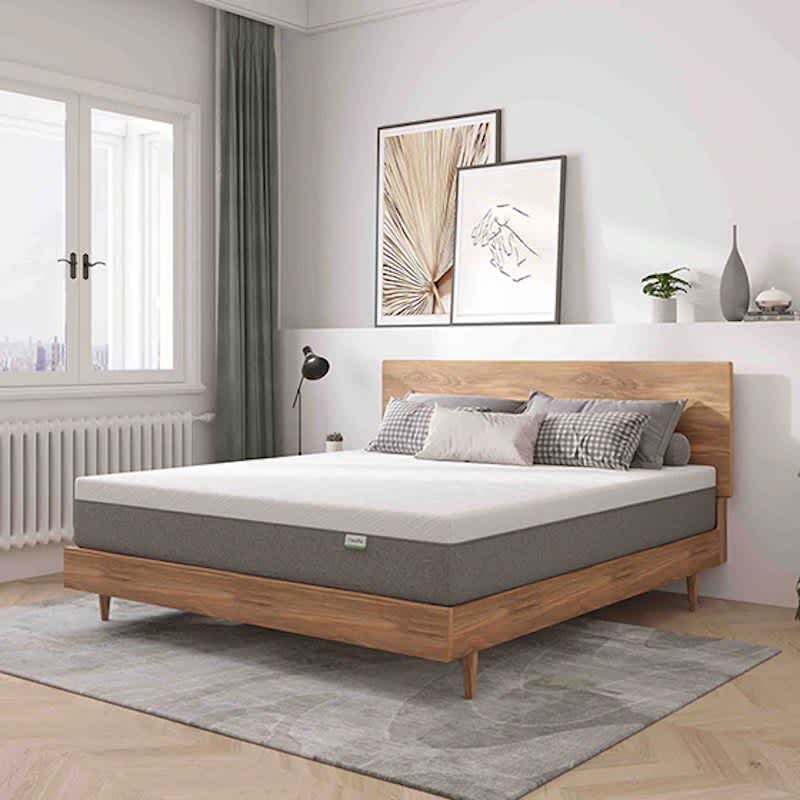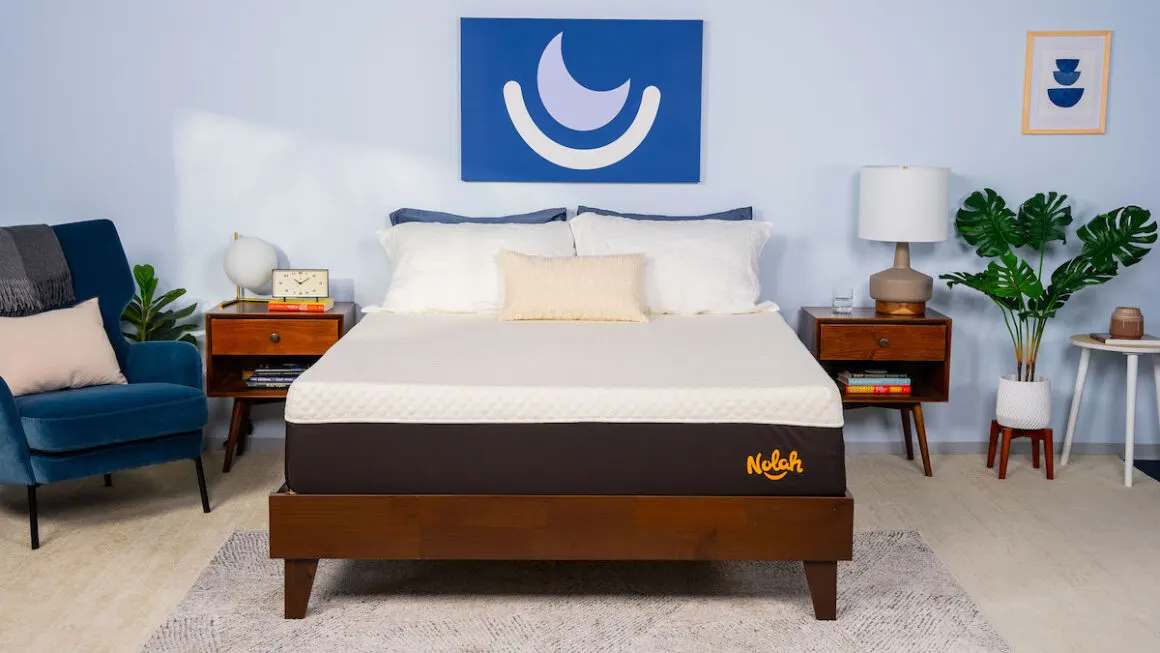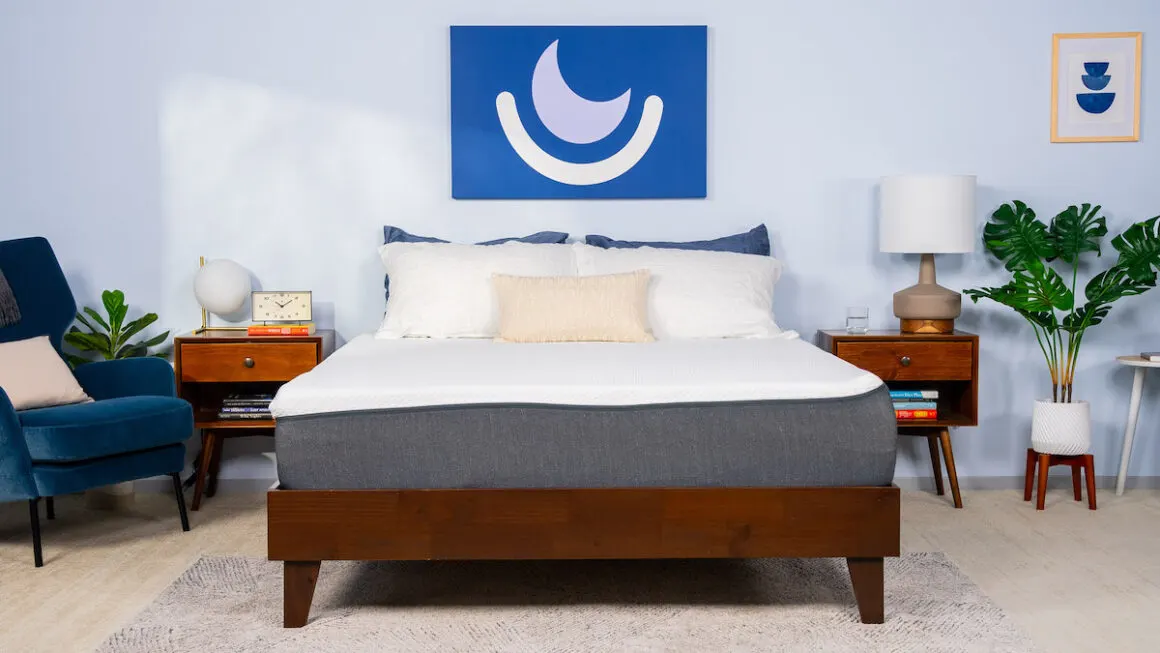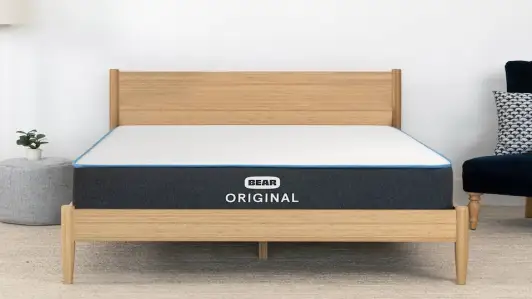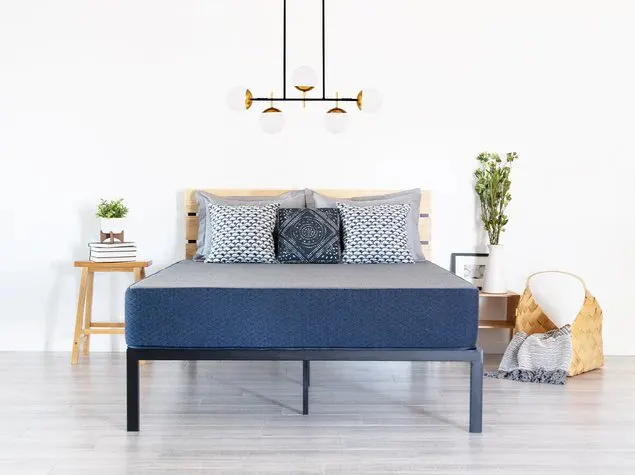Originally developed for NASA in 1966, memory foam is a soft, heat-sensitive material that molds to your body’s shape. Now one of the most popular materials used in mattress construction, memory foam offers sleepers unparalleled contouring, pressure relief, and motion isolation.
Memory foam mattresses are slow to respond to changes in pressure, allowing for a unique cradling effect ideal for side sleepers and those seeking the material’s signature hug.
Best Memory Foam Mattress Overall
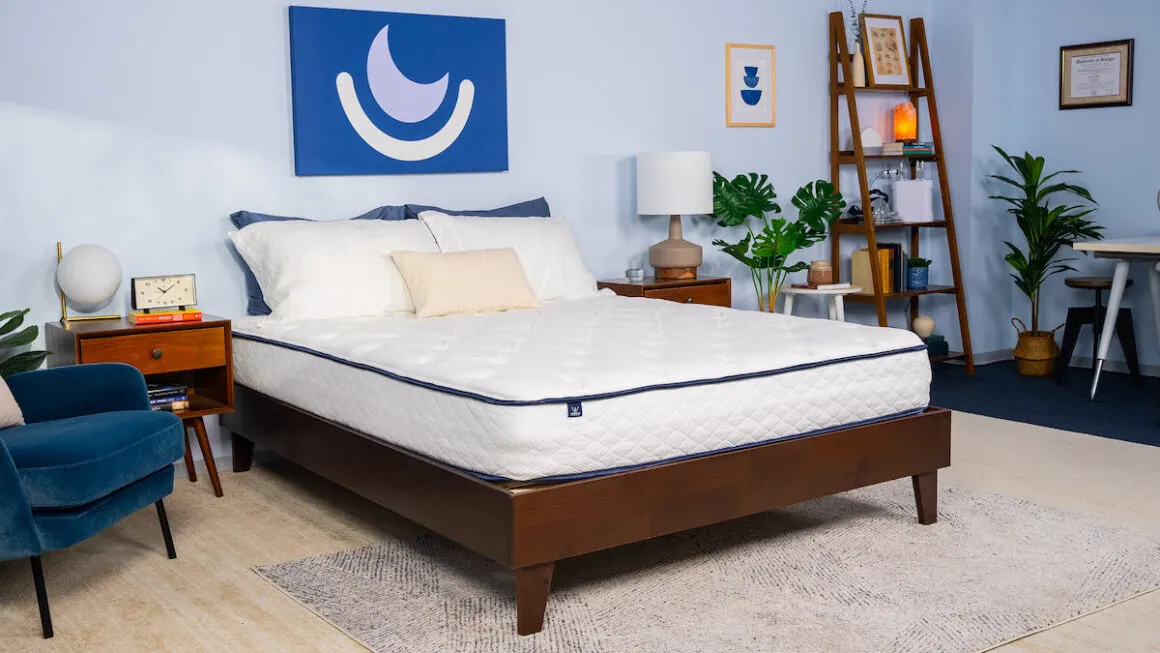
WinkBeds Gravity Lux
The WinkBeds Gravity Lux earns top honors for its balanced feel, providing outstanding pressure relief and a solid support core. It’s three firmness levels make it a versatile pick that works for most people.
The Best Memory Foam Mattresses
Best Overall – WinkBeds GravityLux
Best Value – Novilla Bliss – 12″
Most Comfortable – Nolah Signature 12
Best for Couples – Emma Original Mattress
Best for Combination Sleepers – Bear Original
Best for Guest Rooms – Dreamfoam Essential
Sleep Doctor’s Picks
Best Overall Mattress
WinkBeds GravityLux
The Sleep Doctor’s Review
Available in three firmness levels, the WinkBeds GravityLux uses dense foam layers to contour evenly, distribute your weight, and promote even alignment. We found that this mattress isolates motion exceptionally well and alleviates pressure — especially for side and back sleepers.
Buy from WinkBedsCombination Sleepers
Soft (4), Medium (5), Firm (7)
Supportive For All Sleepers
Good Value
Pros
- Tencel cover tufted with polyfoam gives the surface a plush feel
- Zoned transition layer provides enhanced lumbar support
- Available in three firmness options
Cons
- Dense foams are prone to heat buildup
- Above-average pricing for a memory foam mattress
The all-foam GravityLux comes in medium soft (4), medium (5), and firm (7). With three distinct feels to choose from, our testers had no trouble finding an option that was comfortable for their body type and preferred sleep position. Our team also conducted extensive evaluations on all three firmness levels to determine how their performance varies.
Why We Like It
Most of our testers liked the medium (5) or firm (7) versions, so these may be good options for sleep partners with different body types or position preferences. Team members who weigh over 230 pounds and those who sleep on their backs or stomachs generally preferred the firm, while most under 130 pounds liked the medium. However, some side sleepers under 130 pounds favored the medium soft (4) version. In our partner tests, we observed slightly less motion transfer on the medium soft and medium options. Their extra contouring also relieved our testers’ pressure points to a greater extent. However, we detected lower temperature readings on the surface of the firm option, which may make it better for hot sleepers. Our testers also felt more comfortable moving around on the firm surface and lying along its edge due to the more stable feel.
How Does It Feel?
Featuring a breathable Tencel cover quilted with gel polyfoam, the GravityLux is designed to limit heat retention. Our testers reported that this cover helped the surface stay cool and dry while cushioning their bodies. Beneath the cover, a layer of open-cell memory foam cradles the body, relieving pressure points. The transition layer consists of zoned polyfoam with targeted lumbar support. Our team members noted that their midsections felt well supported by this design feature. The GravityLux also has a durable high-density polyfoam support core.
Best Value Mattress
Novilla Bliss – 12″
The Sleep Doctor’s Review
Deep foam layers and a medium (5) feel allow the Novilla Bliss – 12″ to contour deeply, cradling your entire body and alleviating pressure points in the process. Side sleepers up to 230 pounds on our team were particularly impressed with this affordably priced mattress.
Buy from NovillaSide Sleepers
Medium (5)
Good for Sleepers Under 230 Pounds
Great Value
Pros
- Thick foam comfort system reduces pressure buildup
- Breathable bamboo-derived rayon cover helps regulate surface temperature
- Convoluted polyfoam offers targeted support
Cons
- Foam layers are likely to sink and hinder movement
- Minimal edge support can lead to instability along the perimeter
Memory foam mattresses tend to be lower in price than other mattress types, and the Novilla Bliss 12” is even more affordable than many of its competitors. Along with the lower sticker price, the Bliss’ mid-range feel appealed to many of our testers.
Why We Like It
The Bliss has a medium (5) feel that our side- and back-sleeping testers enjoyed, especially those weighing up to 230 pounds. These testers appreciated the foam comfort system’s cushioning for sore spots. However, stomach sleepers and people weighing more than 230 pounds may need a firmer mattress. Thanks to the all-foam construction, we also recommend the mattress for couples who value motion isolation. We detected minimal motion transfer and noise when we moved across the bed, so you shouldn’t notice your partner’s nightly movement.
How Does It Feel?
A layer of memory foam gives the surface a plush feel that relieves pressure points. This layer is also infused with cooling gel to combat heat buildup. Next is a layer of polyfoam that ensures your weight is evenly distributed across the mattress surface, promoting healthy spinal alignment. A convoluted polyfoam transitional layer offers targeted support to wider areas of your body while preventing you from sinking too deeply into the mattress. High-density polyfoam in the support core reinforces the sleep surface. A breathable cover made from bamboo-derived rayon encases the mattress.
Most Comfortable Mattress
Nolah Signature 12
The Sleep Doctor’s Review
Unlike many of the foam beds we’ve come across, the Nolah Signature 12 is zoned to give you extra lumbar support — and it’s also designed to retain less heat than competing foam models. We give it high marks for side sleepers in particular.
Buy from NolahPressure Relief
Medium (5)
Good for Side Sleepers Up to 230 Pounds
Great Value
Pros
- Proprietary AirFoam cradles the body closely for pressure relief
- All-foam construction with medium (5) feel excels at motion isolation
- Zoned design enhances support for the lower back
Cons
- Back and stomach sleepers over 130 pounds may prefer a firmer bed
- $99 fee is incurred for returns
The Nolah Signature 12 stands out from our other picks due to a layer of specialized AirFoam polyfoam that mimics the adaptive feel of memory foam but is designed to run cooler. It’s a good choice for sleepers who enjoy strong cushioning but tend to overheat on traditional memory foam.
Why We Like It
The mattress excels at pressure relief, with foam layers that conform closely to your body and ease pressure off of sensitive joints. The AirFoam layer on top is zoned to provide extra pushback around the midsection, offering better lumbar support compared to some other foam beds we’ve tested. Motion isolation was another strength of this model, since the foam layers absorb most movement and prevent it from rippling across the surface.
With a medium (5) feel, the mattress appealed most to the side sleepers on our team — especially those weighing up to 230 pounds. Back and stomach sleepers under 130 pounds enjoyed the gentle cushioning while still receiving enough support to keep the lower back from sinking in.
How Does It Feel?
The Nolah Signature 12 has a proprietary polyfoam layer on the surface that comfortably cradles your body. Beneath is a responsive polyfoam layer that enhances contouring but also offers gentle pushback to prevent uncomfortable sinkage. Next is a denser polyfoam that acts as a buffer between your body and the core, which is made of high-density polyfoam for solid support. We found the bed retained a bit less heat than traditional memory foam models, given the open-cell composition of the top foam layer.
Best Mattress for Couples
Emma Original Mattress
The Sleep Doctor’s Review
The Emma Original features a zoned transitional layer and convoluted support core, allowing the mattress to provide above-average support and consistent cooling. All three foam layers absorb movement and practically eliminate transfer, making the mattress particularly well-suited to couples.
Buy from EmmaCouples
Medium (5)
Good for Sleepers Under 230 Pounds
Fair Value
Pros
- Cooling foam sits atop a layer of memory foam for reduced heat retention
- Zoned core offers targeted cushioning and support
- All-foam construction enhances motion isolation
Cons
- Too soft for most back and stomach sleepers over 230 pounds
- Foam layers may restrict movement across the surface
Many memory foam mattresses excel at absorbing movement transfer, and the Emma Original Mattress is no exception. The bed’s foam layers isolated most motion and noise in our tests, making it great if you share the bed with a restless partner.
Why We Like It
A medium (5) feel and adaptive foam construction made the mattress great for almost all of our side sleepers. People who frequently use this position often experience pressure buildup in the hips or shoulders, and the mattress’ foam layers help combat this pressure. Some back and stomach sleepers weighing up to 230 pounds may find the mid-range feel adequately supportive, but people weighing more than 230 pounds may need a firmer mattress. Compared to many other foam mattresses, the Emma performed quite well in our temperature control tests. We attributed this to the extra airflow from the cut outs in the support core.
How Does It Feel?
The comfort system begins with a layer of gel-infused memory foam that adapts to the body to relieve pressure. The gel in this layer is meant to absorb and dissipate excess body heat. Next is a layer of zoned polyfoam that provides extra support for wider areas of the body while cushioning sore spots. High-density polyfoam makes up the support core, offering targeted pushback to prevent uncomfortable sagging. This layer also features cut-outs, which facilitate more airflow. A removable and machine-washable polyester cover encases the mattress.
Best Mattress for Combination Sleepers
Bear Original
The Sleep Doctor’s Review
If you’ve found most foam beds are a touch too plush, the Bear Original could be just what you’re looking for. The above-average firmness is a great fit for sleepers who want the cushioning of foam without the extra deep hug that you’ll find in many memory foam models.
Buy from BearBack and Side Sleepers
Firm (7)
Supportive For Most Sleepers
Great Value
Pros
- All-foam design offers excellent pressure relief
- Strong motion isolation is beneficial for couples
- Cooling cover upgrade helps minimize heat retention
Cons
- Foam is prone to off-gassing in the first few days
- Stomach sleepers over 230 pounds may prefer a firmer bed
The Bear Original caters to sleepers who enjoy the hug of foam but need something a little firmer than the average foam bed. The firm (7) feel is suitable for a wide range of sleep positions and body types, making it a good option for those who switch positions throughout the night.
Why We Like It
During testing, the mattress earned its highest reviews from back sleepers who weighed at least 130 pounds and side sleepers over 230 pounds. It was even comfortable for stomach sleepers weighing up to 230 pounds, a group that often finds foam beds unsuitable due to lack of support. Stomach sleepers over 230 pounds, however, may need a more supportive model.
The foam excelled at absorbing motion, so you shouldn’t feel too much movement if you sleep with a restless partner. Pressure relief was another standout quality of the Original, thanks to the strong cushioning of the foam layers. The bed comfortably cradles your shoulders, hips, and spine.
How Does It Feel?
The Bear Original is composed entirely of foam, beginning with a surface layer of memory foam that closely conforms to your body. Beneath is a polyfoam layer that is very adaptive but also has a firmer feel than the memory foam. The support core contains a thick layer of high-density foam that prevents your body from sinking too far and provides sturdiness to the entire bed. The cover is made of a polyester blend fabric, but you can pay extra for a Celliant-infused fabric engineered to minimize heat buildup.
Best Mattress for Guest Rooms
Dreamfoam Essential
The Sleep Doctor’s Review
Brooklyn Bedding’s Dreamfoam Essential is a wallet-friendly memory foam mattress that’s great for rental properties, guest rooms, and RVs. Five firmness levels — each with a different profile — add to the versatility of this high-value pick.
Buy from Brooklyn BeddingValue Shoppers
Medium Soft (4), Medium (5), Medium Firm (6), Firm (7), Firm (8)
Good for All Sleepers
Excellent Value
Pros
- All-foam design excels at motion isolation and pressure relief
- Available in five firmness levels and nearly two dozen sizes
- Below-average pricing is ideal for shoppers with limited budgets
Cons
- Strong off-gassing odor for the first 72 hours
- Firmness exchanges are not allowed during the trial period
Although the Dreamfoam Essential is comfortable in its own right, an approachable sticker price makes this memory foam mattress particularly well suited to vacation rentals and guest accommodations. The wide range of available sizes also includes 12 RV options if you’re looking for a mattress to take on the road.
Why We Like It
Each of the Essential’s five designs best serves a different type of sleeper. Our tests show the thicker, softer models are ideal for side sleepers who need plush cushioning to reduce pain and soreness in their shoulders and hips. If you prefer the back or stomach position, the firmer, lower-profile designs should provide the support you need to sleep comfortably. The most popular selection was the 10-inch medium firm (6) model — this design offers light contouring, stable support, and a mellow bounce to help you move on the surface.
How Does It Feel?
All versions of the Dreamfoam Essential begin with 2 to 3 inches of memory foam. This material contours closely to distribute your weight, promote even alignment, and prevent excessive pressure buildup along the spine. A gel infusion also helps the surface stay cool, though you may still notice some heat retention. Thicker models add in a transitional polyfoam layer to create more cushioning. High-density polyfoam makes up the support core, and the cover is a knit cover treated to be stain-resistant.
Memory Foam Mattresses vs. Hybrid and Latex Mattresses – Video
In the video below, our product experts explore the differences between memory foam, hybrid, and latex beds by getting hands-on with each mattress type. Watch the video to get a close-up look at how memory foam differs from other popular mattress materials.
What Is a Memory Foam Mattress and Who Is It Best For?
Memory foam is made from a type of plastic called polyurethane. When mixed with other chemicals, the resulting foam has the unique ability to conform under pressure and heat, allowing it to mold to the shape of a person’s body and then slowly return to its original form when pressure is removed.
Memory foam mattresses offer a unique hugging sensation that reduces pressure on the hips, shoulders, and other areas of the body that tend to sink into a mattress. They excel at reducing motion transfer between co-sleepers and are excellent for side sleepers and people with joint pain. However, memory foam mattresses can retain heat and may not offer the bounce or firmness that some people prefer.
Pros
- Excellent pressure relief
- Reduces motion transfer
- Virtually noiseless performance
Cons
- Heat retention
- Minimal bounce
- May feel too soft for some sleepers
What Is the Difference Between Memory Foam and Latex?
Memory foam is made from a special type of plastic, while latex can be produced from the sap of rubber trees or from synthetic materials. Memory foam is softer, molds to your body, and absorbs movement. Latex is generally firmer and bouncier. Latex tends to sleep cooler but is often more expensive than memory foam.
Are Memory Foam Beds a Good Fit for You?
Watch our video below to help decide if memory foam is the right type of mattress for you. We’ll offer a close-up view of how a memory foam mattress performs when you lie on it, and we’ll offer hands-on guidance for determining your compatibility with memory foam beds.
What to Look For in a Memory Foam Mattress
When choosing a memory foam mattress, factors such as firmness, support, temperature control, and price are important to consider to find your perfect match.
Firmness
Firmness affects how deeply a memory foam mattress conforms under pressure. Your ideal firmness level depends on your sleep position and body weight. Side sleepers and lighter individuals often prefer softer foams, while back or stomach sleepers and people over 230 pounds typically need firmer models.
Support
Support describes how well a mattress responds to a sleeper’s body weight to maintain healthy spinal alignment. Because memory foam naturally contours to the body’s curves, it’s able to adjust to different sleeping positions and prevent pressure from building up under heavier areas of the body. However, heavier individuals may find that they sink too deeply to maintain proper alignment.
Temperature Control
It’s important to consider temperature control when buying a memory foam mattress, because memory foam beds tend to retain more heat than other mattress types. Look for options with cooling technologies like gel infusions or perforated foam to enhance breathability and regulate temperature.
Price
Memory foam mattresses come at a range of price-points, from budget-friendly, all-foam models to premium hybrid options. Factors influencing cost include materials, brand, and whether it comes with premium features or cooling technology.
Discover More Mattress Solutions
If you’re in need of an additional mattress — or if you’ve decided a memory foam bed isn’t for you — check out our team’s curated picks for a variety of mattress types.
How We Test
Our product reviews combine expertise and hands-on research to bring you the best memory foam mattresses on the market today. Our Seattle-based team uses a detailed product testing methodology to thoroughly test each mattress we recommend. We also make sure to include the perspectives of team members with different sleep positions and body types to ensure that our recommendations cater to a wide range of needs and preferences.
Frequently Asked Questions
Sleeping on a memory foam mattress feels like being gently cradled. The material contours to your body, providing a unique sensation of sinking softly, which helps to relieve pressure in key areas like the hips and shoulders. Memory foam also minimizes motion transfer, making it ideal if you share the bed and don’t want to feel your partner’s movements.
A memory foam mattress usually refers to an all-foam bed, meaning that it’s constructed of several distinct layers of foam, with softer memory foam on top of denser polyfoam. In contrast, a hybrid mattress combines top layers of foam or latex with a support core of coils. All-foam mattresses typically excel at deep contouring and motion isolation, while hybrids are more responsive and generally sleep cooler.
Memory foam can be excellent for back pain depending on your body type and sleep position. It’s typically most beneficial for lighter individuals who sleep on their side or back due to its ability to conform to the body to evenly distribute body weight and ease pressure points often linked to back pain. By contrast, heavier people and those who sleep on their stomach may find that they sink too deeply into a memory foam mattress to maintain neutral spinal alignment.
All-foam mattresses containing memory foam cost around $1,000 on average, while memory foam hybrids trend closer to $2,000. The cost of a memory foam mattress depends on factors like the foam’s quality, thickness, other layers used in the bed’s construction, and additional features like cooling technologies. Higher-density foams, the use of coils, and premium features usually result in a higher price.
An all-foam memory foam mattress generally lasts about six to seven years, while a memory foam hybrid typically lasts seven to eight years. Longevity also depends on the foam’s quality and density, with higher-density foams tending to last longer. Regular mattress rotation and proper care can also extend the life of a memory foam bed.
Traditional memory foam mattresses can retain heat due to their dense structure and how closely they conform to the body. However, many modern memory foam models incorporate cooling technologies like gel infusions, open-cell structures, or breathable covers to counteract heat retention and provide a cooler sleep surface.
Ask the Sleep Doctor
Have questions about sleep? Submit them here! We use your questions to help us decide topics for articles, videos, and newsletters. We try to answer as many questions as possible. You can also send us an email. Please note, we cannot provide specific medical advice, and always recommend you contact your doctor for any medical matters.

